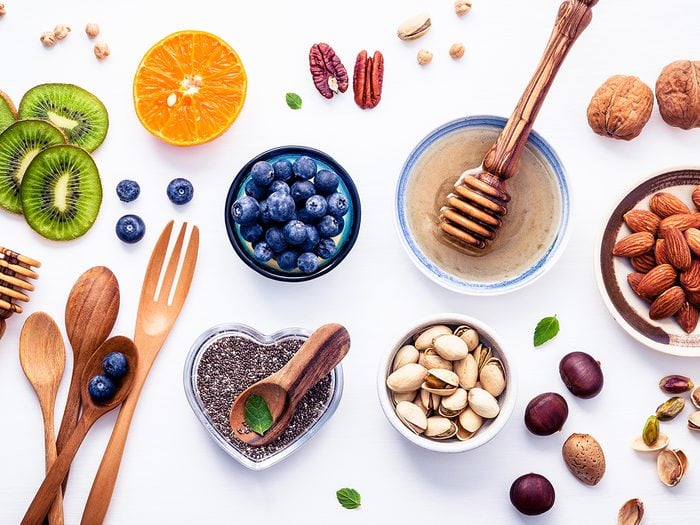
Snacking on the rise
North America is home to snack packs and snack-sized candy bars and resealable plastic bags sized for snacking. We love to snack. While it’s nothing new, between-meal nibbling is on the rise. From 2015 to 2020, Americans went from having 505 snacking occasions per person each year to 530, based on a recent report on U.S. eating patterns conducted by The NDP Group, a market research company. Certainly, the pandemic boosted snacking throughout 2020.And based on a survey conducted by Pollock Communications and Today’s Dietitian, 78 percent of registered dietitian nutritionist respondents said people are moving away from a three-meals-a-day approach to one that features more regular snacking. This isn’t necessarily a bad thing. It’s true that snacks may include chips and other junk foods. But plenty of plant-based foods make for A-plus snacks, and they may be contributing to the rise in snacking.A recent MarketWatch report states that the market for plant-based snacks is anticipated to reach $26.67 billion by 2026. That’s a 4.5 percent increase from 2020. Learn how to choose healthy plant-based snacks that deliver the most nutrition without compromising flavour.(Related: Healthy Store-Bought Snacks to Keep On-Hand When Working From Home)
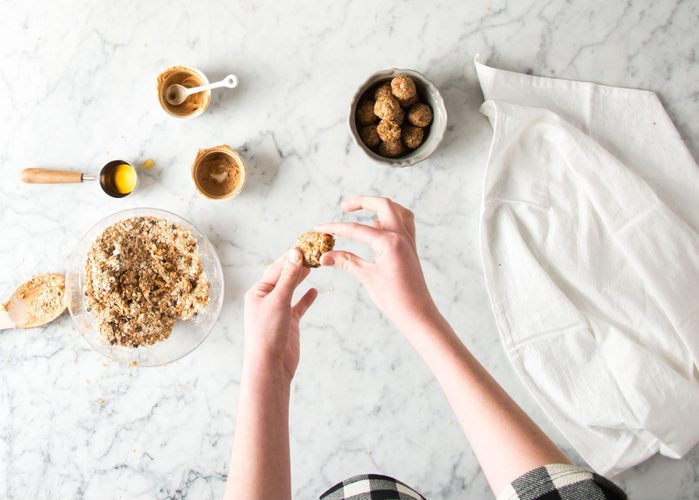
What is healthy snacking?
There’s no right or wrong way to snack on plants. But some approaches are better than others. Munching on a big bag of potato chips is technically plant-based snacking, but everyone agrees it’s not a healthy choice. Enjoying one small handful of potato chips along with plant-based yogurt dip and some fresh veggies is a better approach.
Pay attention to the three P’s
When it comes to healthy snacking, consider the three P’s: plan, portion, and peace. Ideally, plan snacks in advance so you don’t mindlessly grab whatever is in sight during a snack attack. (Let’s be honest, that’s likely to be something sweet, salty, fatty, or all of the above.) Portion snacks out so you’ll know the amount you’re eating, and enjoy snacks while seated peacefully (no devices, if possible), focusing on what you’re eating. Follow all three tips and you’ll lessen your chances of snacking on nutrient-poor foodsand the unintended weight gain that comes from them.
Know why you’re snacking
When planning snacks ahead of time, consider what role they’ll serve. Snacks can keep your metabolism revved up, help with managing weight, fuel performance, and fill in nutrient gaps. For instance, if you know your typical meals lack certain nutrients, you can plan to eat snacks that include them.
Follow the snacking golden rule
And to keep your metabolism humming along, follow the snacking golden rule: don’t go more than five hours during the day without eating something. If lunch is at noon and dinner isn’t until 8 p.m., plan a snack for 4 or 5 p.m.(Related: 6 Things Parents Say that May Trigger Disordered Eating in Kids)
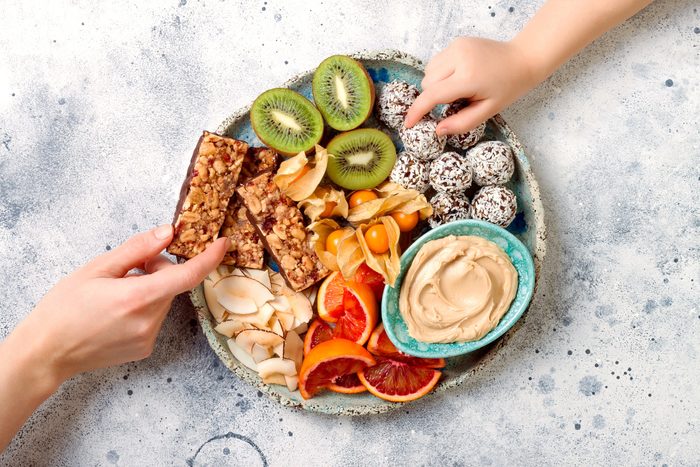
What’s in a healthful plant-based snack?
Snacks can include foods we typically think of as “snack food.” But don’t limit yourself to these items alone. Dinner leftovers or snack-sized versions of breakfast are also good snack options. Your between-meal nibbles might be fancy, or they could be super basic. They may be a single food or combo of foods.While there isn’t an exact calorie guideline applicable to everyone, 150 to 200 calories is a healthy range for a snack. Keep in mind that calorie needs vary from day to day based on activity level. Got high energy needs? Your body may thrive on a 250-calorie nosh. Regardless, calorie counting isn’t necessary. Aim for a snack-sized portion and let your brain and stomach guide you. (Just be careful to stop when you’re full; it can be easy to go overboard, especially if you didn’t pre-portion your snack or are eating it while doing something else.)Aim for nutrient-rich and satisfying snacks, which will carry your appetite from one meal to the next. The duo of fibre and protein is notably filling, and that can ultimately help weight-management efforts.Hungry? Fix yourself one of these well-balanced and totally delicious plant-based snack options.(Related: 9 Healthy Crunchy Snacks)
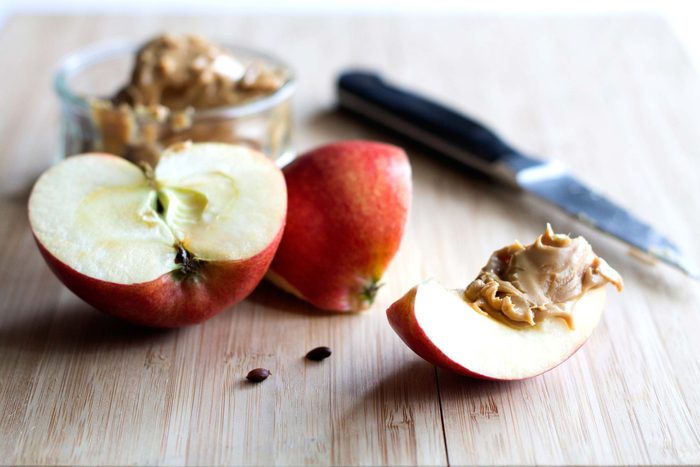
Fruit, nut, and cheese plate
It doesn’t get much easier than grabbing a crisp apple. A medium apple with skin provides about 95 calories, plus significant fibre, potassium, vitamin B6, and polyphenols. According to 2016 report published in EXCLI Journal, eating apples may be associated with a long list of benefits, including protection against cancer, cardiovascular diseases, diabetes, and obesity. (And there is that age-old “apple a day” adagefind out if it’s true.)Pick whichever apple variety you like. Scrub it well to help remove any pesticide residues. Slice the apple, then pair it with a protein-containing food for balance. Have a little cube of firm (aged) tree-nut cheese with each apple slice, or spread soft tree-nut cheese onto apple wedges.A typical one-ounce serving of soft cashew cheese provides 100 calories and four grams of protein, and a firm almond cheese provides 70 calories and six grams of plant protein. It’s an enjoyable combination, especially when you serve it attractively as a cheese plate or board. Want a high-performance upgrade? Pair with pistachios too.(Related: 13 Surprising Health Benefits of Apples)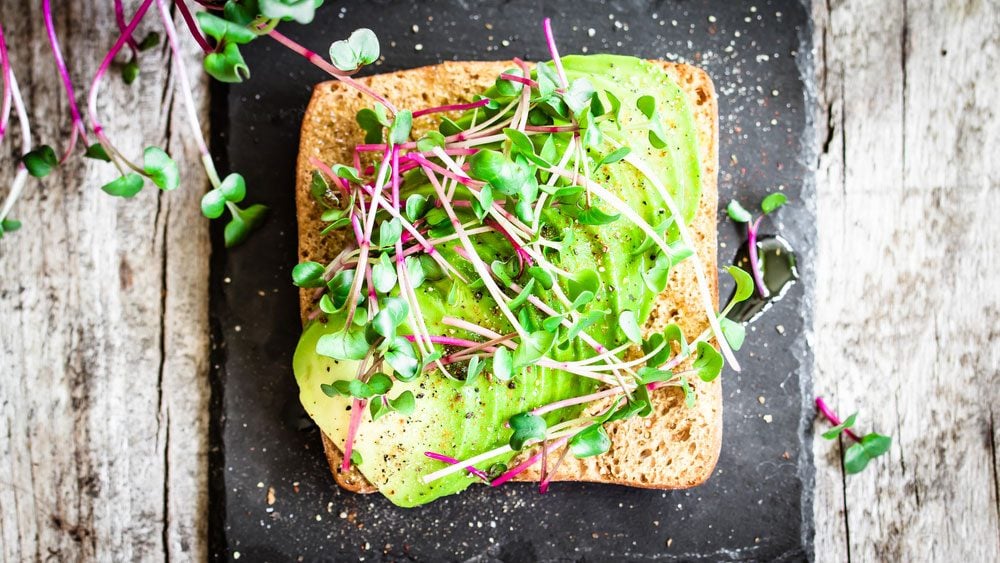
Avocado on sprouted-grain toast with lemon and hemp seeds
Avocado aficionados often enjoy avocado toast for breakfast. It’s also an ideal snack-time choice. The fruit provides filling fibre and a wealth of nutrients, including potassium, lutein, and zeaxanthin. It has a luxurious mouthfeel, thanks to healthy fats, and will keep you full and satisfied. Snacking on avocado may aid your weight-loss efforts. A 2019 study published in Nutrients found that people who regularly ate avocados gained less weight than those who didn’t eat avocados.Cut your avocado, smash the flesh, and spread over sprouted grain toast, then top with lemon juice and shelled hemp seeds. Compared with its non-sprouted grain counterparts, sprouted-grain bread has more prevalent essential amino acids and antioxidants, and its nutrients are more available to your body. That’s according to a separate 2019 comprehensive review in Nutrients. The hemp seeds you’ll sprinkle on top are a notable source of fibre, protein, and healthy fatsa satiety trifecta.Studies, like those reviewed in a 2020 Nutrients report, support the seed’s role as a functional food due to its anti-inflammatory, antioxidant, antihypertensive, neuroprotective properties, among others. Want a high-performance upgrade? Sprinkle with shelled edamame too.(Related: What Happens When You Eat Avocado Every Day)
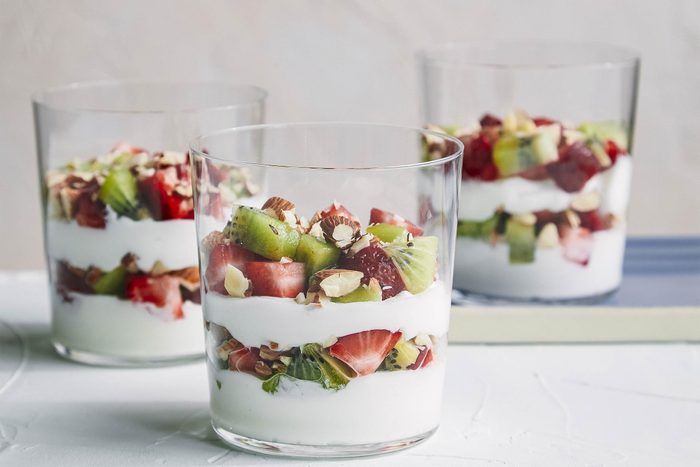
Strawberry parfait
Looking for a palate-pleasing and eye-appealing option? Try healthy, homemade parfait. In a jar, layer organic strawberries with unsweetened vanilla almond milk Greek-style yogurt. Your snack is ready instantly, though you can store it in the fridge. Strawberries offer a naturally sweet way to get vitamin C, potassium, folate, fibre, and various phytonutrients. One of the fruit’s standout phytonutrients is ellagic acid, which has antioxidant and anti-inflammatory properties and may help reduce the risk of diabetes, protect the heart and nerve cells, and offer prebiotic benefits.Organic berries are tops because of the sustainable agricultural method in which the berries are produced. When combined with unsweetened plant-based yogurt, you’ve practically got dessert with no added sugars. In one handy 5.3-ounce container of unsweetened vanilla almond milk Greek-style yogurt, you’ll find 160 calories, a whopping 11 grams of plant protein, and 4 grams of fibre. Plus, you’ll get live, active cultures, which are so good for your gut. Want a high-performance upgrade? Layer with granola.(Related: 10 Surprising Ways Strawberries Can Benefit Your Health)
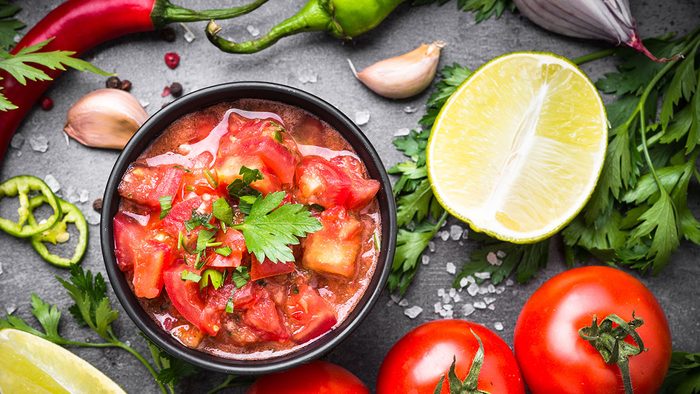
Salsa and “cream cheese” whole grain tortilla roll-up
Yep, salsa counts as produce. When tomatoes are heat-processed to make salsa, they offer some special benefits. Cooking tomatoes enhances their lycopene content, a healthy carotenoid that’s associated with protective roles for certain cancers, cardiovascular diseases, and other chronic diseases, according to a 2021 review published in Antioxidants.Mix your tomato-based salsa with plant-based “cream cheese” and roll it up in a whole grain tortilla. Lycopene is better absorbed when coupled with fatthat’s where “cream cheese” comes in. Look for a plain cream cheese alternative made with almond milk. Expect a two-tablespoon serving to provide 70 calories, six grams of total fat (with zero grams of saturated fat!), and two grams of plant protein.The zesty, creamy filling is all wrapped up in a whole grain tortilla. Choose a sprouted grain one, if you can. Either way, this provides more protein and good carbs (including fibre) for sustained energy. For a high-performance upgrade, add in mashed black beans or black bean dip.(Also Try: A Spicy Berry Fruit Salsa We Love to Make for a Backyard Party)
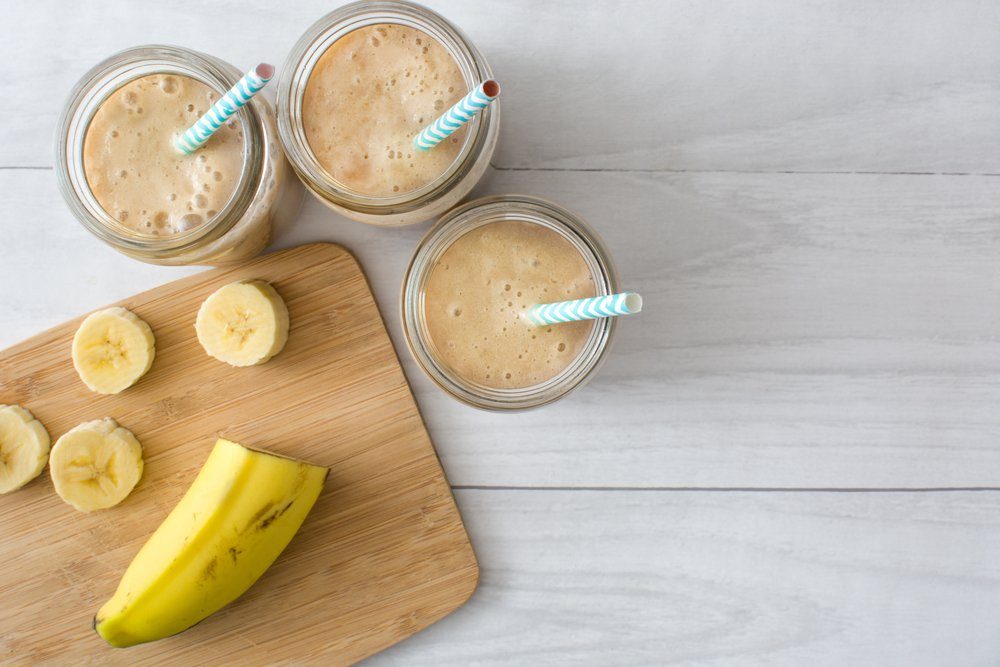
Banana shake with plant-based milk and yogurt
Got some past-their-prime bananas? They’re perfect for smoothies. The fruit is known for being rich in potassium. It also contains a wealth of bioactive compounds, including carotenoids and phenolic compounds, and offers a bevy of potential benefits, providing anti-inflammatory, anti-allergenic, and antiviral properties.Peel, slice, and freeze ripe bananas so you can whirl up this shake anytime. You’ll blend a heaping handful of those frozen banana slices with a couple of generous splashes of plant-based milk. Unsweetened vanilla almond milk is a good option. To that, add a few big spoonfuls of plant-based yogurt. You can use Greek-style yogurtjust like in the strawberry parfait recipe abovefor a punch of protein. Altogether, you’ve got a nourishing, refreshing, ultra-creamy beverage. It’s an excellent post-workout snack too. Want a high-performance upgrade? Blend in a dollop of nut or seed butter.(Also Try: A Banana Pear Smoothie)
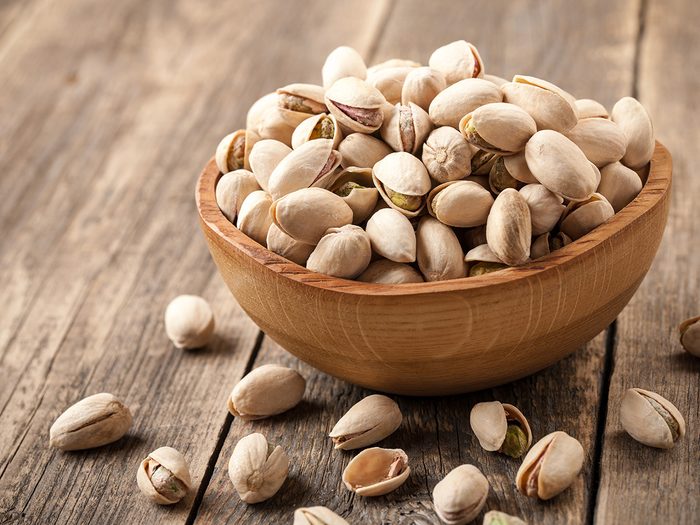
Pistachio salad
A salad isn’t just a lunchtime entre or dinnertime side. It’s also a delightful snack. Start with any green you likeor go for a variety. Toss with lemon juice and extra-virgin olive oilor another healthy salad dressing or vinaigrette. And absolutely don’t forget the topping: a handful of pistachios. One serving of pistachios provide three grams of fibre and six grams of plant protein, including all nine essential amino acids.A 2020 randomized, controlled study of 100 overweight or obese adults published in Nutrients, found that participants whoate 1.5 ounces of pistachios per day got more fibre and ate fewer sweets than members of a control group who didn’t eat pistachios. Eating pistachios was also linked to an increase in levels of certain carotenoids (antioxidants) and a decrease in blood pressure. To get a high-performance upgrade, sprinkle your salad with crumbled, soft plant-based cheese.(Related: Are Pistachios Good for You? Their Nutrition, Calories, and Health Benefits)
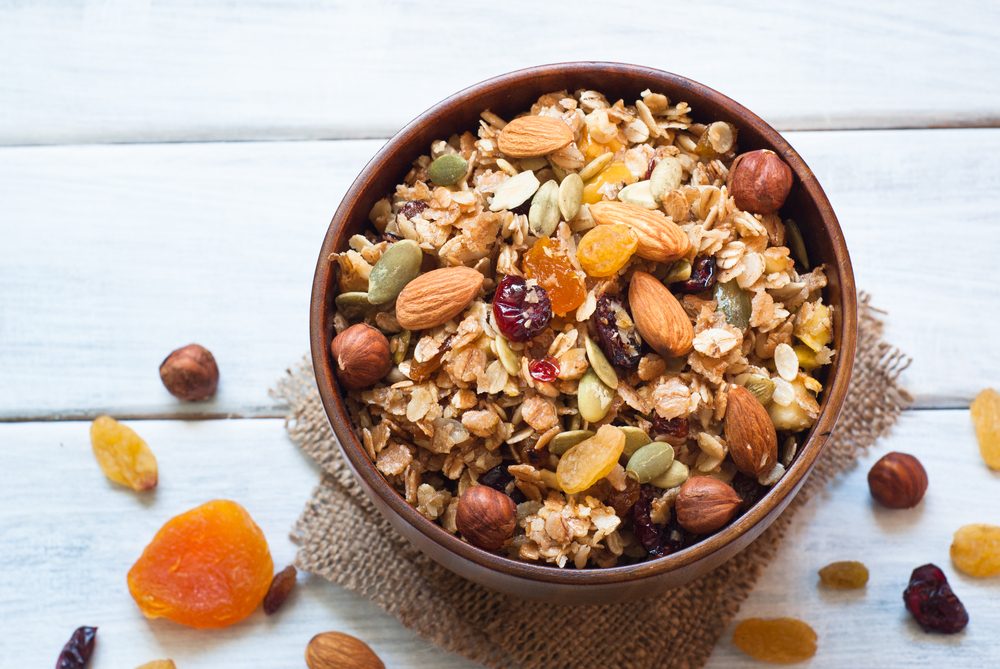
Gorp
It’s unclear where the original term “gorp” came fromsome say it stands for granola, oats, raisins, and peanuts, though there is a dictionary from the early 1900s that defines gorp as eating greedily. Whatever its origins, this version makes for a simple snack: good ol’ raisins and peanuts.There’s a good reason hikers, exercise enthusiasts, and other health food fans eat trail mix for energy. Raisins offer concentrated carbs for a quick burst of energy, thanks to about 19 grams of naturally occurring sugar in a one-ounce serving. And peanuts provide staying power. Generally speaking, eating a handful of nuts a day may help replace not-so-healthful foods, thereby playing a potential role in preventing obesity and type 2 diabetes. A 2017 study in Nutrients found a link between eating peanuts and improvement of nutrient intake, post-meal blood glucose, and satiety.Nuts may be high in fat, but that doesn’t mean they’ll make you gain weight. In fact, a 2015 study in Nutrients found no link between eating peanuts and gaining body fat, even when participants ate as much as 70 grams (nearly 2.5 ounces) a day. Get a high-performance upgrade by adding another dried fruit and nut or seed to your trail mix. (And, yes, it’s perfectly fine to toss in dark chocolate chips occasionally.)(Also Try: PB and Honey Trail Mix Bites)
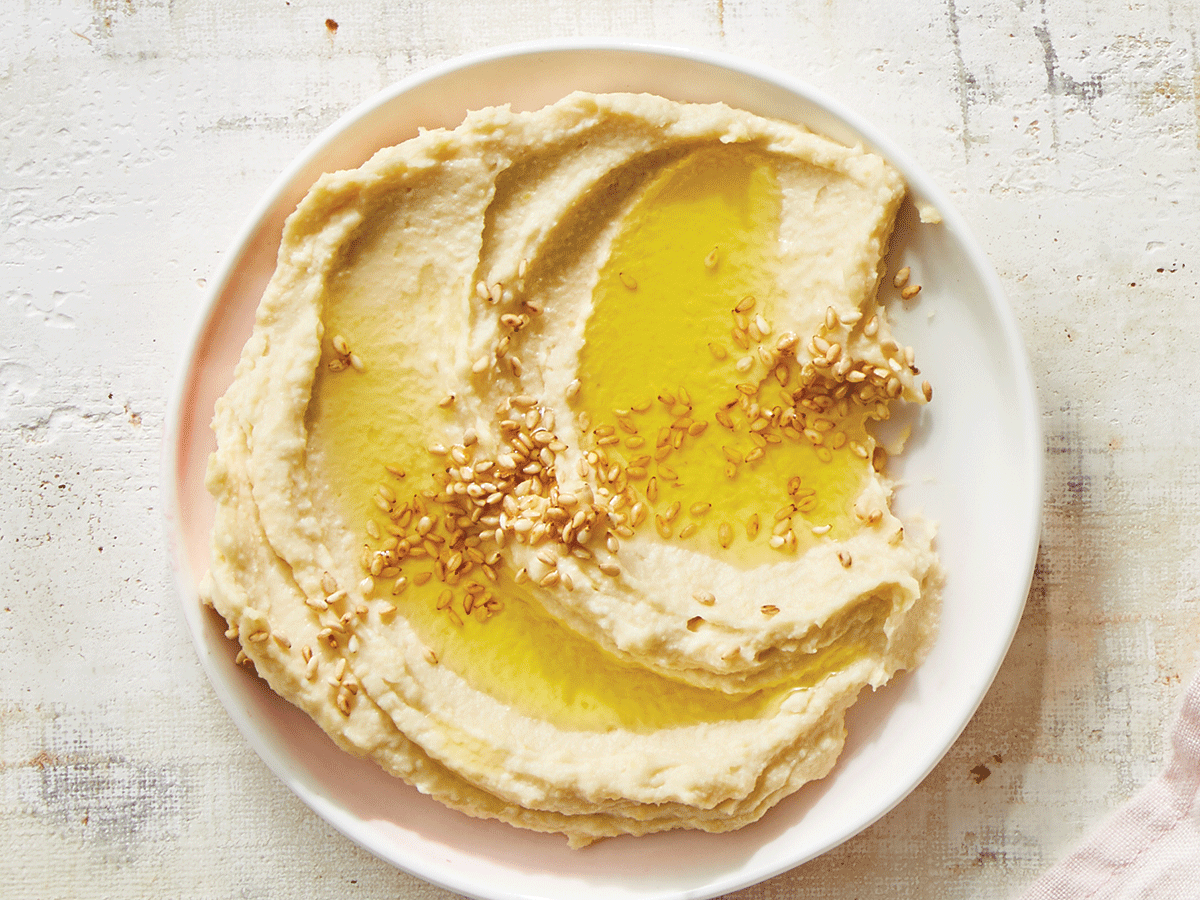
Dippers & hummus
Parents say that serving veggies with dip helps kids eat more of them. A 2017 study in Current Nutrition Reports found this holds true when kids have bitter-sensitive palates and they’re served vegetables like broccoli and cauliflower. This trick may work on yourself too. Try dipping mini sweet peppers into hummus for a great afternoon nibble. According to a 2019 study in Antioxidants, peppers offer protection against degenerative diseases, thanks to their carotenoids.Hummus is made with garbanzo beans (chickpeas). Beans are packed with antioxidants and fibre while offering many other health-protective benefits. When beans are in the form of hummus, these benefits still apply. In fact, a 2020 review published in Nutrients found that eating hummus may boost diet quality and may be linked to better management of appetite, blood sugar, and blood lipid levels.Blend up a batch of homemade hummus. It’s easy. Easier still: buy a container of it from your local deli. Want a high-performance upgrade? Pair with a whole-grain pita or pita chips.Next: 11 Healthy Late-Night Snacks Nutritionists Actually Recommend
The post 8 Healthy Plant-Based Snack Ideas You’ll Actually Want to Eat appeared first on Best Health Magazine Canada.


0 Commentaires